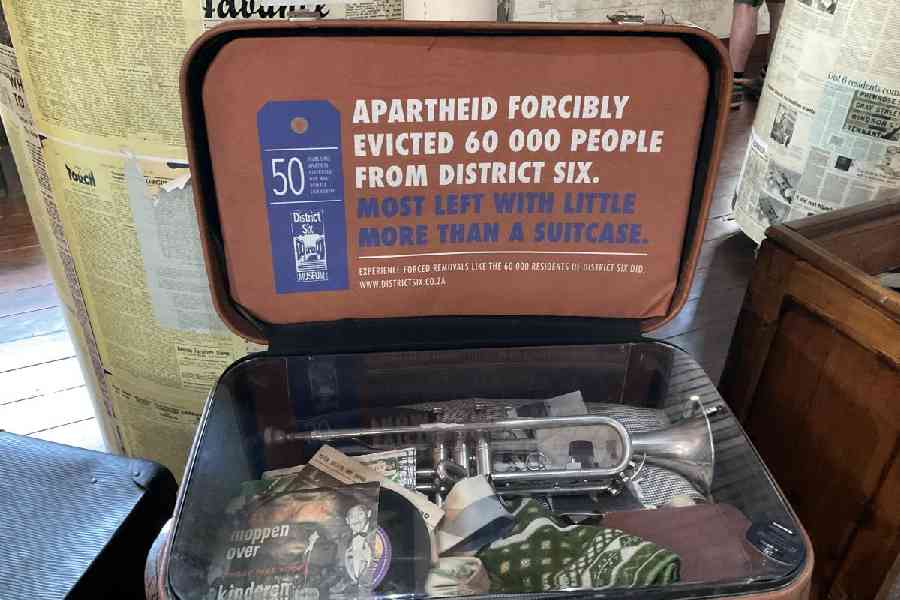I saw her in a museum of displaced people, in a neighbourhood in Cape Town where the downtown starts to melt into the desolate. The desolation in District Six is the subject of the museum named after it. In her traditional headscarf and abaya, the woman, sturdied and seasoned with age and suffering, looked displaced in that museum of displacement. And so she belonged there, alive and unsettling among the images of lives and rooms that once belonged to people before they were bulldozed to the ground.
It was one of the saddest losses of life, community, and happiness in the history of South Africa. District Six was a low-income, inner-city neighbourhood occupied primarily by freed slaves and indentured labourers, migrants, artisans and factory workers. It was a picture of the rainbow nation as it existed before apartheid, made up of Xhosas, Indians, a small number of white Afrikaner and English, and a large number of Muslim people classified under apartheid as ‘coloured’, most of them Cape Malay. But racial mixing was anathema for apartheid city-planning, and in 1966, the neighbourhood was declared a ‘whites-only’ zone under the Group Areas Act. The demolition of houses and the forced removal of people that started in 1968 led to the displacement of over 60,000 people, who lost their lives, homes, and communities in a place that they had fondly called their own and which had represented, for all its poverty, one of the happiest multicultural and multiracial communities in South Africa before racial segregation.
A Cape Malay woman, then but a girl — the woman in the abaya — has the most vivid memory of being displaced. She remembers it all — the happiness and the intimacy of the neighbourhood, much like Richard Rive’s classic novel, ‘Buckingham Palace’, District Six, the parades and the carnivals, the corner shops and the gossipy neighbours who watched out for one another. When the news came that they would be displaced to make space for a new, white neighbourhood, it was greeted with cheery disbelief — how are they going to displace so many of us from our homes? And then the bulldozers came with their deathly destruction, the arrogance of an engineering modernity that had carved the path from colonialism to the holocaust. Like other acts of hubristic planning, they were to fail staggeringly, with the multiracial population scattered all over Cape Town, notably along the Cape Flats where crime and poverty remain high to this day, and with few whites coming forward to live in the cleared area, much of it remains an empty, desolate stretch of land to this day.
She told the story — her story, their story, and the story of a nation — with passion, pain, and pride, and it gave me queasy gooseflesh. She was now part of the museum’s staff, its resident storyteller, but was she not also an exhibit? What does it mean to tell the story of a lost happiness and a desolate destruction to tourists, travellers and experience-seekers day after day, month after month, year after year? Is she happy to take hold of the narrative, tell her story to the world, as they come to Cape Town? Or does she feel like one of those victims of violence who feel violated every time they have to tell the story of their violation, before the judge, the psychiatrist, and the public? Who could tell?
The Truth and Reconciliation Commission, constructed at the end of apartheid, had placed memory, story, and witnessing at the heart of the encounter with the ugliest and the most destructive tolls taken by the racist regime. Storytelling is now inseparable from the dark monuments in South Africa, but it is telling, vivid and deeply unsettling when the teller is the one who has lived through the pain. On Robben Island, less than an hour’s ferry ride from Cape Town, where Nelson Mandela spent the longest stretch of his 27-year-old prison sentence, we were met by an elderly black man who greeted us with the question: “Are you ready to go to prison?” Laughing nervously, the ferry-full of travellers had little idea of what was to come soon to deepen their unease into gloom.
We entered the maximum-security prison that reminded me of Alcatraz Island off the coast of San Francisco. But prisoners had escaped even from Alcatraz, as the Clint Eastwood starrer, Escape from Alcatraz, fictionalised memorably. But Robben Island, used by European colonisers as the site of incarceration for political prisoners since the 17th century, was an absolute death trap as a maximum-security prison for the apartheid government. In its 30-odd years as a prison for black and coloured opponents of apartheid, our elderly guide assured, with a pall of darkness around him, not even one prisoner had managed to escape Robben Island. The barbed wires, the electric fences, the fierce dogs formed an insurmountable barrier before the poor convicts could throw them into the chilling waters of the Atlantic, seven kilometres from the nearest shore in Cape Town.
Reverence fought with a strange fear and the strangest unease when our guide dropped in casually that he had spent the last seven years of apartheid rule in this prison. Protesting against divisive policies in education that sought to keep the black population enslaved in servitude, he was imprisoned, and the last years of his prison term were to see cloistered life in the very narrow passage, lined with cells, in which we found ourselves right then. Seating us on the benches of a communal prison-room that held sixty at a time, he marched up and down, his heavy body slow, his speech slow but booming, as he told us that in this prison they were but numbers. He took us to the kitchen where he showed us the prison menu that had apartheid inscribed on it, with black prisoners getting a lower portion and fewer choices than Indian and coloured prisoners. He walked us past the cell where Rolihlahla Nelson Mandela spent long years in solitary confinement, the rolled-up mattress on the floor and the tiny grilled window looking out on the blue Cape sky of impossible freedom.
He did not want this job, he said. But he could not find a job in the new, liberated South Africa. Robben Island called him back to be one of its designated storytellers. He tells the story of that life from which he was once freed, day after day, month after month, year after year. Like much of South Africa that recounts its dark and painful past, he remains narrator, archive, and exhibit.
Saikat Majumdar is Professor of English and Creative Writing at Ashoka University










